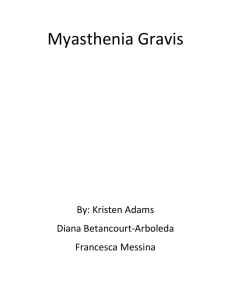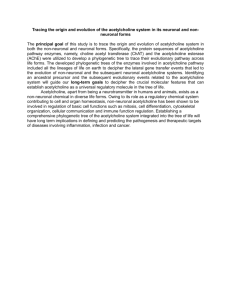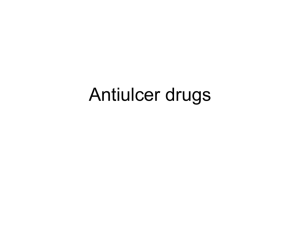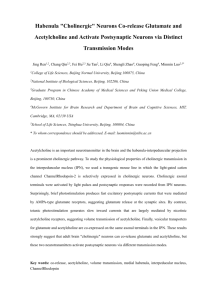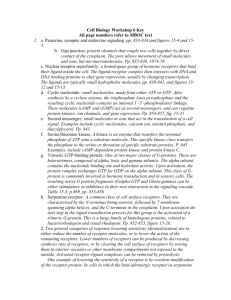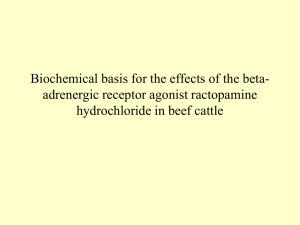THE UNIVERSITY OF SYDNEY
advertisement
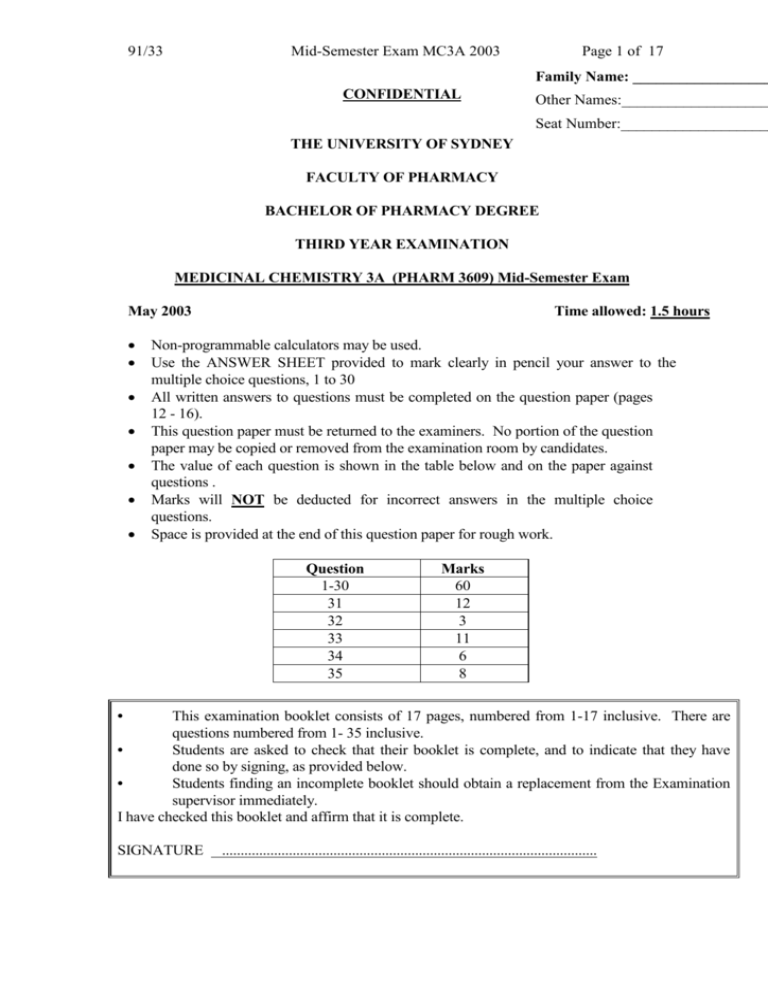
91/33 Mid-Semester Exam MC3A 2003 Page 1 of 17 Family Name: __________________ CONFIDENTIAL Other Names:___________________ Seat Number:___________________ THE UNIVERSITY OF SYDNEY FACULTY OF PHARMACY BACHELOR OF PHARMACY DEGREE THIRD YEAR EXAMINATION MEDICINAL CHEMISTRY 3A (PHARM 3609) Mid-Semester Exam May 2003 Time allowed: 1.5 hours Non-programmable calculators may be used. Use the ANSWER SHEET provided to mark clearly in pencil your answer to the multiple choice questions, 1 to 30 All written answers to questions must be completed on the question paper (pages 12 - 16). This question paper must be returned to the examiners. No portion of the question paper may be copied or removed from the examination room by candidates. The value of each question is shown in the table below and on the paper against questions . Marks will NOT be deducted for incorrect answers in the multiple choice questions. Space is provided at the end of this question paper for rough work. Question 1-30 31 32 33 34 35 Marks 60 12 3 11 6 8 • This examination booklet consists of 17 pages, numbered from 1-17 inclusive. There are questions numbered from 1- 35 inclusive. • Students are asked to check that their booklet is complete, and to indicate that they have done so by signing, as provided below. • Students finding an incomplete booklet should obtain a replacement from the Examination supervisor immediately. I have checked this booklet and affirm that it is complete. SIGNATURE ..................................................................................................... 91/33 Mid-Semester Exam MC3A 2003 Page 2 of 17 Q1. Acetylcholine is a neurotransmitter A. B. C. D. E. at ganglionic synapses of both the parasympathetic and sympathetic nervous system. at ganglionic synapses in the parasympathetic nervous system only. at ganglionic synapses of the sympathetic nervous system only. at all synapses in the human nervous system. at synapses in the peripheral nervous system only. Q2. The acyl (acetyl) group of acetylcholine at muscarinic receptors: O + (CH3 )3 N A. B. C. D. E. CH2 CH2 O C CH3 Cl cannot be altered without loss of agonist activity. can be changed by only one or two carbons (e.g. propionyl or formyl groups) with minimal loss of agonist activity. can be increased by up to five carbons without loss of potency as an agonist. can be replaced by a benzoyl linkage with retention of agonist activity. can be replaced by almost any group with retention of agonist activity, since this site is well away from the onium group. Q3. The quaternary ammonium group of acetylcholine, with respect to agonist activity at muscarinic receptors A. B. C. D. E. can be replaced with any medium sized hydrophobic group since it binds to a hydrophobic cavity on the receptor. cannot be altered from the trimethylammonium group without almost complete loss of potency. (?????) can be increased in size by substitution of two methyl groups with only minimal loss of potency. can be increased in size by substitution of three methyl groups with only minimal loss of potency. can be increased in size by three methyl substitutions with only minimal loss of potency. Q4. The ester linkage in acetylcholine acting as an agonist on muscarinic receptors A. B. C. D. E. cannot be varied without complete loss of activity. allows acetylcholine to act transiently as a neurotransmitter due to its rapid hydrolysis by acetylcholinesterase. limits the usefulness of acetylcholine as a drug because of its transient action. B and C are correct. A, B and C are correct. 91/33 Mid-Semester Exam MC3A 2003 Page 3 of 17 Q5. If the ether oxygen (within the ester group) of acetylcholine is changed to a sulphur (S) atom, the agonist activity at muscarinic receptors is: A. B. C. D. E. unaffected. lost completely. retained, but with lower potency, because thiol esters are hydrolysed only slowly by acetylcholinesterase. retained, but with lower potency, because it produces a lower maximal response (low intrinsic activity). retained, but with considerably lower potency, because S has altered electronic and hydrophobic properties compared to oxygen. Q6. The specificity of acetylcholine for muscarinic receptors relative to nicotinic receptors can be INCREASED by: A. B. C. D. E. altering the acetyl group to a carbamate (O-CO-NH2) group altering the acetyl group to a carbamate and addition of a methyl substituent on the carbon in the position - to the onium group. addition of a methyl substituent on the carbon in the position - to the onium group. all of the above. B and C are correct. Q7. The specificity of acetylcholine for muscarinic receptor subtypes: A. B. C. D. E. cannot be achieved because acetylcholine analogues must retain conformational flexibility in order to interact with muscarinic receptors. can be achieved by alterations in the acyl group. can be achieved by alterations of both the acyl and onium groups. can be achieved by making the molecule rigid through restriction of freedom of rotation of certain bonds. can be achieved only with naturally occurring compounds (e.g. pilocarpine, muscarine). Q8. An accepted pharmacophore model for the acetylcholine muscarinic receptor has the following features: A. B. C. D. E. An onium anionic binding site. A hydrogen bonding (or dipole-dipole) site 3A from the onium site. A methyl cavity. All of the above. A and B are correct. 91/33 Mid-Semester Exam MC3A 2003 Page 4 of 17 Q9. Introduction of a -methyl substituent in the side chain of acetylcholine A. B. C. D. E. has no effect on biological activity. (since all it does is decrease likelihood of hydrolysis). will enhance muscarinic receptor potency irrespective of the stereospecificity of the substitution. will enhance muscarinic receptor selectivity only when the methyl substitution is stereospecific ( (+)-configuration ). only when the methyl substitution is stereospecific ( (-)-configuration ). is irrelevant, since there is no asymmetric centre created. Q10. A therapeutically useful muscarinic receptor antagonist may be obtained as follows: A. B. C. D. E. from natural plant sources. by adding one aromatic ring to the acetyl function of the acetylcholine backbone. by adding two aromatic rings and a hydroxyl group to the acetyl group of the acetylcholine backbone. (also requires larger groups on the onium head??) A, B and C above. A and C above. Q11. For anti-muscarinic an optimal distance between the onium nitrogen and the hydrophobic substituents in the acyl portion of acetylcholine is achieved A. with a variety of linkage structures. B. only when the ester linkage of acetylcholine is retained. C. only when there is a non-ester linkage between functional groups. D. only when the linkage is formed by a cyclic ring. E. only when there is a –OH substituent in the linkage group. Q12. Subtype selective muscarinic receptor antagonists are A. B. C. D. E. naturally occurring (e.g. plants such as deadly nightshade). synthetic derivatives with a structure often totally unlike that of atropine or acetylcholine. structures that appear unrelated to acetylcholine but in fact have a similar electronic arrangement of groups (e.g. analogs of oxotremorine). structures that are less conformationally flexible than acetylcholine or atropine, and have conformations favouring a particular receptor (e.g. M1 receptors). ?????????????? not available yet. 91/33 Mid-Semester Exam MC3A 2003 Page 5 of 17 Q13. The following structure (DMPP or dimethylphenylpiperazine chloride) is a nicotinic receptor agonist for the following reasons + N CH3 N Cl CH3 A. B. C. D. E. DMPP It provides a two point attachment (the positive nitrogen and the electronegative N-phenyl group). It provides a three point attachment, as in all known drug receptor interactions. It provides an onium group analogous to the trimethylammonium group in acetylcholine. It is a bis-onium compound related to the ganglion blocker hexamethonium. A and C above. Q14. Nicotine and dimethylphenylpiperazinium share the following common features A. B. C. D. E. They both block the ganglionic nicotinic receptor by bridging two anionic sites. They both block the ganglionic nicotinic receptor by depolarising the postganglionic nerve, eventually leaving the cell refractory to the action of acetylcholine. They both act to competitively block access of acetylcholine to the receptor. They both are currently applied therapeutically to lower blood pressure. None of the above. Q15. O + (CH3 )3 N (CH2 )10 + N(CH3 )3 + (CH3 )3 N CH 2 CH2 O C CH2 2 Decamethonium and succinylcholine are neuromuscular blockers A. B. C. D. E. with a similar hydrophobicity. with a similar distance separating their trimethylammonium groups. with the same pharmacokinetics of neuromuscular blockade. which differ in the duration of neuromuscular blockade due to differences in their hydrophobicities. B and C are correct. 91/33 Mid-Semester Exam MC3A 2003 Page 6 of 17 Q16. Comparing decamethonium and d-tubocurarine A. B. C. D. E. they both produce neuromuscular (NM) blockade by a similar mechanism of action. decamethonium’s NM blockade can be overcome by increasing the concentration of acetylcholine at the NM junction. d-tubocuranine’s NM blockade can be overcome by increasing the concentration of acetylcholine at the NM junction. decamethonium was developed from d-tubocuranine by maintaining the same distance between the ammonium groups (14A). C and D are correct. Q17. d-tubocurarine CH3 HO + NH CH2 OCH3 O CH2 + N H3 CO O H3 C CH3 HO d-tubocurarine is the basis of newer NM junction blockers by upholding the following principles: A. B. C. D. E. the distance between the two ammonium groups is around 14A. the chemical scaffold separating the two ammonium groups must be based on that of the acetylcholine molecule. the chemical scaffold between the ammonium groups exhibits wide structural variation (e.g. steroid structures, tetrahydroisoquinolines). A and B are correct. A and C are correct. 91/33 Mid-Semester Exam MC3A 2003 Page 7 of 17 Q18. O O C CH 3 N CH 3 + (CH 3 )3N X Neostigmine is an acetylcholinesterase inhibitor with the following properties. A. B. C. D. E. reversible, with a similar mechanism of action to Tacrine. reversible, but it forms a covalent interaction with the enzyme which is extremely short lived (microseconds). reversible, but it forms a covalent interaction with the enzyme which has a medium lifetime (minutes). reversible, but it forms a covalent bond with the enzyme which has a long lifetime (hours). irreversible, because it forms a covalent bond with the enzyme esteratic site. Q19. Neostigmine can be used therapeutically as follows A. B. C. D. E. For glaucoma due to its inhibition of acetylcholine breakdown and very long onset and duration of action (hours to days). for glaucoma, due to its inhibition of acetylcholine breakdown, and medium onset and duration of action (minutes to hours). as an insecticide due to its anticholinesterase activity and destruction of insect CNS following uptake across the cuticle. A and C. B and C. Q20. Organophosphates, such as malathion, are: A. B. C. D. E. essentially irreversible inhibitors of acetylcholinesterase, useful as insecticides for many days. essentially irreversible inhibitors of acetylcholinesterase, with limited usefulness as insecticides, because the inhibition is readily reversed on contact with water. irreversible inhibitors of acetylcholinesterase, because they interact with a serine hydroxyl group in the active site and the reaction is reversed within tens of minutes. irreversible inhibitors of acetylcholinesterase because they react with the imidazole nitrogen in the esteratic site. not used widely as insecticides because there is no antidote to agricultural poisoning. 91/33 Mid-Semester Exam MC3A 2003 Page 8 of 17 Q21. Pralidoxime is effective as an antidote for organophosophate-inhibited acetylcholinesterase due to: + N CH N OH I CH3 A. B. C. D. E. Pralidoxime it being a quaternary ammonium compound which is orientated towards the active site by interaction with the ammonium binding site of the enzyme. the oxime group which is a strong nucleophile and attacks the electrophilic phosphorylated-enzyme bond. the presence of both the ammonium group and the oxime group in adjacent positions on the aromatic ring. the presence of both the ammonium group and the strong oxime nucleophilic group, irrespective of the distance between the two groups. the ability of the pralidoxime to form a complex with the organophosphate, thereby preventing it from being absorbed and hence reacting with the acetylchoinesterase. Q22. A patient who has been poisoned by an organophosphate should be treated as follows: A. B. C. D. E. A muscarinic agonist plus pralidoxime. A muscarinic antagonist plus pralidoxime given at any time after ingestion. A muscarinic antagonist followed by pralidoxime within one minute. A muscarinic antagonist followed by pralidoxime given within a few hours of ingestion. pralidoxime alone, since muscarinic antagonists (such as atropine) are toxic and the pralidoxime has sufficient antimuscarinic potency of its own. 91/33 Mid-Semester Exam MC3A 2003 Page 9 of 17 Q23. The following is the structure of noradrenaline. HO HO CH CH2 NHCH3 OH The compound is A. B. C. D. E. a phenylethylamine. a catecholamine. a neurotransmitter at all sympathetic nerves. a neurotransmitter at all central and peripheral nerves. A and B above. Q24. Noradrenaline is more potent than isoprenaline at -adrenergic receptors because A. B. C. D. E. it is a catecholamine. it has a small substituent on the nitrogen in the ethylamine side chain. it has an hydroxy group in the ethylamine chain. All of the above. B and C are correct. Q25. The duration of action of noradrenaline has been increased as follows A. B. C. D. E. by substituting the 3,4-dihydroxy aromatic substituent with a 3,5-dihydroxy substituent. by removing the catechol groups catechol, hence preventing metabolism by catechol O-methyl transferase. by shortening the length of the ethylamine side chain. by removing the hydroxyl substitution in the ethylamine side chain, and hence preventing oxidation by cytochrome P450. All of the above. Q26. Isoprenaline has an isopropyl group substituent on the ethylamine nitrogen in place of the methyl substituent in noradrenaline. This provides it with the following features. A. B. C. D. E. increased potency for both 1 and 2 adrenergic receptors. increased potency for 2 receptors in the bronchial smooth muscle. Both and -adrenergic potency, with marginal -receptor selectivity. greater resistance to both catecholamine-transferase and monoamine oxidase metabolism. A and D are correct. 91/33 Mid-Semester Exam MC3A 2003 Page 10 of 17 Q27. Selective 2 adrenergic receptor antagonists such as salbutamol, useful in asthma by pulmonary inhalation administration, have the following properties: OH HC CH2 NH C(CH3 )3 CH2 OH A. B. C. D. E. OH enhanced duration of action due to not being a catecholamine. a hydroxy substituent in the side chain, which allows a central component of action. the presence of isopropyl group substitution on the nitrogen, which makes the compound a partial -receptor antagonist. All of the above. A and B above. (I THINK b also because Beta must have at least one substituent. But I don’t’ know… ) Q28. Propranolol, shown below, demonstrates the following features in the design of adrenergic blockers. CH3 O NH CH3 OH A. B. C. D. E. An isopropyl group, which enhances adrenergic receptor interaction. An hydroxy group in the side chain, which provides receptor interaction. A bulky aromatic substituent appropriately separated from the ethylamine linker. A sufficiently subtle substitution on the catechol group of isoproterenol, which provides some partial agonist activity. All of the above. 91/33 Mid-Semester Exam MC3A 2003 Page 11 of 17 Q29. Amphetamines are sometimes abused because CH 3 CH2 CH A. B. C. D. E. NH 2 they are direct acting catecholamines which interact with CNS adrenergic receptors, producing an “adrenaline rush”. they are indirect acting agents because they lack the catechol group. they cross the blood-brain barrier being more hydrophobic than the direct acting catecholamines because of the lack of a side chain hydroxy group and/or the presence of an alkyl substituent. they release noradrenaline and adrenaline after being taken up into the nerve endings. B, C and D are correct. Q30. The difference in pharmacological activity between clonidine and naphazoline is as follows: Cl N H N CH2 N H N N H Cl Naphazoline Clonidine A. B. C. D. E. Naphazoline has a -CH2- group in place of the -N=, so that it acts on different receptors to clonidine. Clonidine is more hydrophobic in character, hence crosses the blood brain barrier and interacts with receptors, blocking the release of catecholamines in the periphery. Clonidine is more hydrophobic in character, hence crosses the blood brain barrier and interacts with 2 receptors, blocking the release of catecholamines in the periphery. A and B are correct. A and C are correct. 91/33 Mid-Semester Exam MC3A 2003 Page 12 of 17 Q31. Joe Blow aged 18 was diagnosed with schizophrenia. He was initially prescribed chlorpromazine but later given clozapine. (Total 12 marks) (i) (ii) (iii) (iv) What are the main structural features important for antipsychotic activity associated with chlorpromazine? (3 marks) What conformation does the propyl side chain adopt when binding; do all conformations have activity? Explain your answer. (3 marks) What receptor(s) does chlorpromazine bind to and how does this equate to any side effects? (3 marks) Compare and contrast the therapeutic effects of chlorpromazine with clozapine. (3 marks) CH3 N N S Cl N (CH2 )3 Cl N(CH3)2 Chlorpromazine N N H Clozapine 91/33 Mid-Semester Exam MC3A 2003 Page 13 of 17 Q32. Sumatriptan was developed as an anti-migraine drug. What is the mode of action? (3 marks) N(CH3)2 H3 C NH O S O Sumatriptan N H 91/33 Mid-Semester Exam MC3A 2003 Page 14 of 17 Q33. As the Chief Medicinal Chemist of Pain Therapeutics, Inc., you are in charge of drug design and development. You have been asked by the Managing Director (MD) to design and develop a drug for pain management superior to morphine. Your tasks involve: (i) Evaluating the structure-activity relationship of the C-ring of morphine. (5 marks) (ii) Determine how you would convert morphine, a µ opioid agonist, into a µ opioid antagonist. (4 marks) (iii) Give an example of a µ opioid antagonist and what is its clinical application. (2 marks); HO O NCH3 H HO Morphine i) - converting the OH at the 6 position to a keto will increase activity - removing the 7-8 double bond will allow the molecule to adopt a chair conformation (rather than the boat) and activity will increase - adding a OH group at the 14 position will increase activity - Do no place the OH at the 8 position as this will decrease activity ii) Firstly, we can change the N group into an allyl group or a cyclopentylmethyl group. This will give the molecule some antagonistic activities but will also retain some agonist activity (nalorphine). Inserting OH at the 14 position will sterically hinder the molecule such as the n group will be away from the OH. This configuration preferentially acts as a mu antagonist. iii) naloxone which is used to treat heroin overdose and recover breathing depression. 91/33 Mid-Semester Exam MC3A 2003 Page 15 of 17 Q34. Discuss the metabolism of codeine and determine why codeine is less potent as an analgesic than morphine? (6 marks) Codeine has a CH3O at the three position instead of the OH group of morphine. It is less potent than morphine due to this group. When the 3 position is protected, it does not interact with the opiod receptors, making codeine more effective as an anti-tussive. However, codeine does have some analgesic effect because 10% of codeine is converted into normorhpine where O methylation occurs first, followed by N demethylation. 90% of the molecule then goes to N demethylation without first undergoing O demethylation. It is also possible for conjugation to occur at the 3 position and glucoronidation to occur at the 6 position. (insert structures). 91/33 Mid-Semester Exam MC3A 2003 Page 16 of 17 Q35. Most local anaesthetics are tertiary amines (pKa 7.0-9.0) that block nerve conductance by binding to selective site(s) on the voltage-gated Na+ channel. Briefly outline the local anaesthetic pharmacophore and explain why the cation-to-base ratio is critical to nerve conduction block. (8 marks) 91/33 Mid-Semester Exam MC3A 2003 Page 17 of 17 Space provided for rough working If JD took morphine tablets would she be suffering from respiratory depression? Explain your answer in terms of the metabolic pathway(s) of heroin and morphine. Show chemical structures where appropriate (6 marks). Yes she would be. Because of the two acetyl groups, heroin is quickly hydrolysed in the body to produce morphine. The ease of hydrolysis means that the conversion is 100%. It is this morphine that is responsible for the breathing depression and so taking pure morphine will result in the similar outcomes. (ii) Draw the structure of naloxone. What chemical features are needed to convert morphine into the µ-opioid antagonist naloxone? Explain why (6 marks)? The 7-8 double bond is removed to increase activity The OH at the 6 position is replaced by the keto to increase acitivty The OH at the 3 position is free to bind with opioid receptors The N group is converted into an allyl group or a cyclopentylmethyl group in order to give it antagonistic activity Oh is added in the 14th position to sterically hinder the N group such that it is preferentially an antagonist. 91/33 Mid-Semester Exam MC3A 2003 Page 18 of 17 The methyl group at the 2 position gives good torsion angles to improve selectivity. This methyl group also protects the N in the ring and prevents P450 degradation. There is no substitution at the 2 or 6 position on the biaryl group which reduces activity due to steric interaction We have improved hypolocomotor activity Substituent at 4 position increases activity and oral availability. Also have good activity if F on 5 position
